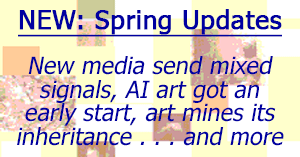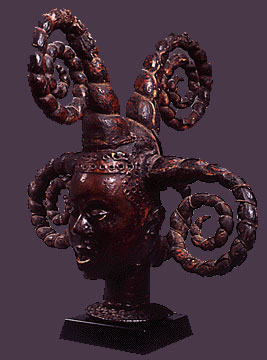6.30.25 — Keep On Dancing
At El Museo del Barrio, the dancing never stops. Put it down to a museum with a taste for local color in New York and the Americas, wherever its exhibitions care to go.
 Put it down, too, to the technological magic of video, which still captures dance in Brazil in 1980. It need never quit the length of a museum wall or the entirety of museum hours in remembering Salvador da Bahia, where Mestre Didi dedicated his life to “Spiritual Form.” Put it down most of all to a country where none can escape the carnival and few would dream of trying. A retrospective reaches out to embrace all manner of dancing, in life and in art, through July 13.
Put it down, too, to the technological magic of video, which still captures dance in Brazil in 1980. It need never quit the length of a museum wall or the entirety of museum hours in remembering Salvador da Bahia, where Mestre Didi dedicated his life to “Spiritual Form.” Put it down most of all to a country where none can escape the carnival and few would dream of trying. A retrospective reaches out to embrace all manner of dancing, in life and in art, through July 13.
Depending on which way you enter, the dance may precede him. Didi, born Deoscóredes Maximiliano dos Santos, was still just hitting his stride when Arlete Soares gathered her fellow dancers to put on a show. They may press singly toward the picture plane in black and white or weave in a tightly choreographed mass. Their white dresses only emphasize their body weight. The mestre was lighter in weight in more ways than one. His sculpture stands tall, lean, and just as active at the center of each room.
Just thirty works hold the floor, sharing the museum with a larger retrospective of Candida Alvarez. Leather-bound sheaves form decorative patterns touched by flowers in photos the size of the wall. Beneath it lie still more patterns in reproduction with much the same motifs. A step inside the show has it coming actively into being. In another photo, you can see him binding the tapestry in palm ribs. Again the dance and the layering keep coming.
He works calmly and steadily. These are his orishas, or “scepters,” and he is weaving a “sacred site” in deference. This is solid ground, populated by ziggurats and cowrie shells, but the patterns are largely planar. Didi showed his work easily back then, but Bahia is not Rio, and he has largely fallen off the map, at least in New York. He died in 2013 well into his nineties. Here, though, he can once again serve as a central place for local artists, Yoruba tradition, and the currents that fed the artist himself.
 The curators, Rodrigo Moura and Ayrson Heráclitof with Chloë Courtney, treat the occasion as a group show of nearly a dozen other mischief makers, like the dancers from forty-five years ago. This is not a survey of Brazilian art, which has had no shortage of attention with its woven histories, South American architecture, and photographic “Fotoclubismo.” Shows have focused on such artists as Hélio Oiticica, Tarsila do Amaral, Lygia Clark, and Lygia Pape. Didi’s version of Latin American art skipped the carnival in Rio in search of the spiritual. It shares its strategies with others all the same as recently as today. It obliges one to think harder about what they have in common behind him on the wall.
The curators, Rodrigo Moura and Ayrson Heráclitof with Chloë Courtney, treat the occasion as a group show of nearly a dozen other mischief makers, like the dancers from forty-five years ago. This is not a survey of Brazilian art, which has had no shortage of attention with its woven histories, South American architecture, and photographic “Fotoclubismo.” Shows have focused on such artists as Hélio Oiticica, Tarsila do Amaral, Lygia Clark, and Lygia Pape. Didi’s version of Latin American art skipped the carnival in Rio in search of the spiritual. It shares its strategies with others all the same as recently as today. It obliges one to think harder about what they have in common behind him on the wall.
They may work with bold geometric abstraction like Rubem Valentim or, like Goya Lopes, in silkscreen on red floral textiles. They may turn to craft, like Nádia Taquary in basketry and beads. They may have freestanding geometric sculpture, like Emanoel Araújo, or dark cast metal masks like Agnaldo Manoel dos Santos flat to the wall. Jorge dos Anjos tells stories in ink, while paintings by Abdias Nascimento are colorful, mythic, and playful. Antonio Oloxedê creates scepters of his own. Like Didi, they see no contradiction between the spiritual and the dance.
Read more, now in a feature-length article on this site.



